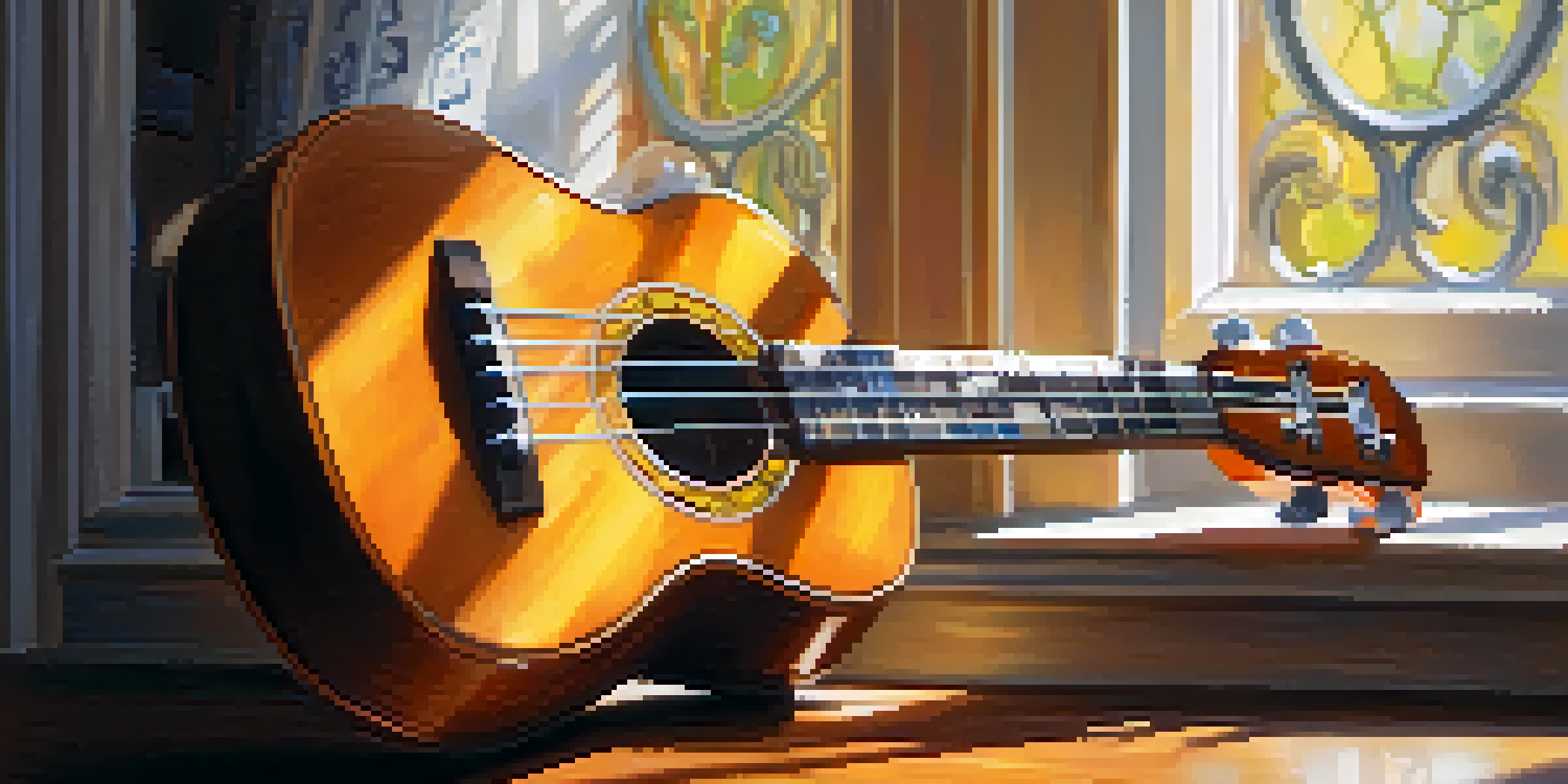The Importance of Timing and Rhythm in Ukulele Playing

The Foundation: Why Timing Matters in Music
Timing is the heartbeat of music; it sets the pace and flow of a song. Just like a metronome clicks away, maintaining consistent timing ensures that musicians stay together, creating a harmonious sound. For ukulele players, mastering timing is crucial because it allows them to sync with other instruments or vocalists, enhancing the overall performance.
Music is the shorthand of emotion.
Imagine a band where everyone plays at different speeds. The result would be chaotic and unpleasing to the ear. This is why understanding timing is essential—it's the glue that holds the music together. A well-timed strum can elevate a simple chord progression into something magical, making the piece more engaging.
In essence, good timing not only affects how music sounds but also how it feels. It influences the emotional impact of a piece, guiding listeners through the highs and lows with precision. For any aspiring ukulele player, grasping the importance of timing is the first step towards creating captivating music.
Rhythm: The Pulse of Your Ukulele Playing
Rhythm refers to the pattern of sounds and silences in music, acting as the framework that supports melody and harmony. For ukulele players, understanding rhythm is just as important as knowing chords or finger placements. It’s what gives music its character, allowing players to convey different emotions and styles.

Think of rhythm as the dance of your fingers on the strings. Whether you’re strumming a lively upbeat song or a slow ballad, the rhythm defines how the music moves. Different rhythms can evoke various feelings; a fast tempo might make listeners want to dance, while a slower one could inspire reflection.
Timing is Key to Musical Harmony
Mastering timing allows musicians to sync effectively, creating a cohesive and engaging sound.
By practicing various rhythmic patterns, ukulele players can expand their musical repertoire and versatility. This exploration not only improves their technical skills but also enhances their creativity, allowing them to experiment with different styles and genres. Ultimately, rhythm breathes life into your playing.
The Role of Timing in Song Structure
Every song has a structure, typically comprising verses, choruses, and bridges, and timing plays a critical role in this arrangement. Understanding where to emphasize beats can make or break a performance. For instance, a well-timed pause before a chorus can build anticipation, making the music more engaging.
Timing is everything. If you don’t have timing, you don’t have anything.
Consider how a dramatic pause in a movie heightens the tension before a big reveal. In music, timing works similarly; it guides the listener’s emotional journey through the song. A ukulele player who masters song structure can manipulate timing to create powerful moments that resonate with their audience.
This mastery of timing within song structure not only showcases musicality but also enhances storytelling through music. Each note, strum, and rest contributes to the narrative, making timing an essential skill for any serious ukulele musician.
Practicing Timing: Techniques for Improvement
Improving your timing on the ukulele doesn’t have to be daunting. One effective method is to practice with a metronome, which helps establish a consistent tempo. Start slow, focusing on accuracy, and gradually increase the speed as you become more comfortable. This approach builds a solid foundation that can enhance your overall timing.
Another great technique is to play along with recordings of your favorite songs. This not only helps you internalize the rhythm but also teaches you how timing works within a full musical context. By mimicking professional players, you can learn to identify and replicate their rhythmic nuances, enriching your own playing style.
Rhythm Shapes Emotional Expression
Understanding rhythm enables ukulele players to convey different emotions and styles, enhancing their musical versatility.
Finally, consider playing with other musicians whenever possible. Jamming with friends or joining a ukulele group can significantly improve your timing skills. The interactive nature of playing with others provides real-time feedback and a fun way to practice, making it easier to develop a good sense of timing.
The Connection Between Timing and Feel
Timing is not just about being on beat; it’s also about how you interpret that beat. This is often referred to as 'feel'—the unique way a player adds their personality to a song. For ukulele players, developing a sense of feel can transform a standard chord progression into something special, resonating deeply with listeners.
Imagine two musicians playing the same song; one might play it strictly on the beat, while the other adds subtle variations in timing. The latter can bring a song to life, creating a sense of groove that makes it irresistible. This is where timing and feel intertwine, allowing players to express their individuality.
By experimenting with timing and finding your own feel, you can create a signature style that sets you apart. This journey of discovery not only enhances your playing but also allows you to connect with your audience on a deeper level, making your music more impactful.
Common Timing Mistakes to Avoid
Even seasoned musicians can fall victim to timing mistakes, which can hinder their playing. One common error is rushing through sections of a song, often due to excitement or nerves. This can result in a disjointed performance that lacks cohesion, so it’s essential to maintain a steady pace throughout.
Another mistake is neglecting rests and pauses. Many beginners focus solely on playing notes, overlooking the importance of silence in music. Rests are just as crucial as the notes themselves; they create space and emphasis, allowing the music to breathe and providing contrast to the melody.
Mistakes Can Disrupt Timing
Common timing mistakes, such as rushing or neglecting rests, can hinder a performance and disrupt the overall flow of music.
Lastly, failing to listen to the ensemble while playing can lead to timing issues. It’s vital to stay aware of how your part fits into the whole. By actively listening and adjusting your timing accordingly, you can enhance not only your performance but also the overall sound of the group.
The Joy of Mastering Timing and Rhythm
Mastering timing and rhythm on the ukulele opens up a world of musical possibilities. Once you grasp these concepts, you’ll find yourself playing with increased confidence and creativity. The joy of making music is amplified when you can effortlessly flow through different rhythms and timing variations.
Consider the feeling of jamming with friends, where everyone is locked in and the music flows seamlessly. That shared experience is made possible by a solid understanding of timing and rhythm. It creates a sense of unity, allowing each player to shine while contributing to the collective sound.

Ultimately, the journey to mastering timing and rhythm is not just about technical skill; it’s about the joy of expression and connection through music. As you continue to develop these skills, you’ll find that your love for the ukulele grows deeper, and so does your ability to create unforgettable musical moments.